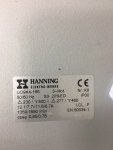MD Automation
Senior Member
- Location
- Maryland
- Occupation
- Engineer
OK – good to know there is not a tripping breaker between the VFD and motor.
What I would think to check first is that the motor is wired for the correct voltage. Inside the motor connection box, check that the jumpers are wired / strapped for low voltage. If they are accidentally connected for high voltage, the motor might actually work ok if it is lightly loaded. The available torque will be greatly reduced, but if the lifting load is small enough it might get the load up. But at some point, with enough load and too little torque available, the motor slip will increase or possibly stall completely. And maybe, setup as it is, the breaker feeding the VFD is the first thing to clear that fault? Having said that, I’d expect the VFD to trip first though. But checking the jumpers is so easy, I’d do that first.
I assume this is a motorized Car Park? Have you seen this problem firsthand? If so, does it appear that the motor slows down and labors under heavy loads before the breaker opens? Or does the travel speed look normal, even for the loads that trip.
Looking at your PDF, it appears the VFD is programmed for a 1700 rpm motor at 60Hz, drawing 6A at 200V full load. Make sure this matches up with the nameplate data. And if you are comfortable checking the VFD parameter setup, you might do that after looking at the motor wiring to rule out some dumb programming problem. I found that Fenner VFD documentation easy enough to look up online. I also would have to assume that this is a properly engineered system, and that the issue is hopefully something simple like mis-wired motor voltage – rather than some fundamental design flaw.
Is the 20A breaker that trips part of the control panel design and supplied and selected by the manufacturer? Or was it installed and supplied separately? Have you tried asking for help from the manufacturer?
Sounds like you are unavailable to head to the site due to COVID-19 travel restrictions, so I figure this might have to wait since you’d really like to eyeball some of this personally. If I read your initial post correctly, you indicate that there are some lifts that give you no trouble? If so, that’s a great thing for troubleshooting – you have known good system you can look at and compare against for things like motor wiring / VFD setup / amp clamp measurements on VFD mains supply, etc.
Good luck.
What I would think to check first is that the motor is wired for the correct voltage. Inside the motor connection box, check that the jumpers are wired / strapped for low voltage. If they are accidentally connected for high voltage, the motor might actually work ok if it is lightly loaded. The available torque will be greatly reduced, but if the lifting load is small enough it might get the load up. But at some point, with enough load and too little torque available, the motor slip will increase or possibly stall completely. And maybe, setup as it is, the breaker feeding the VFD is the first thing to clear that fault? Having said that, I’d expect the VFD to trip first though. But checking the jumpers is so easy, I’d do that first.
I assume this is a motorized Car Park? Have you seen this problem firsthand? If so, does it appear that the motor slows down and labors under heavy loads before the breaker opens? Or does the travel speed look normal, even for the loads that trip.
Looking at your PDF, it appears the VFD is programmed for a 1700 rpm motor at 60Hz, drawing 6A at 200V full load. Make sure this matches up with the nameplate data. And if you are comfortable checking the VFD parameter setup, you might do that after looking at the motor wiring to rule out some dumb programming problem. I found that Fenner VFD documentation easy enough to look up online. I also would have to assume that this is a properly engineered system, and that the issue is hopefully something simple like mis-wired motor voltage – rather than some fundamental design flaw.
Is the 20A breaker that trips part of the control panel design and supplied and selected by the manufacturer? Or was it installed and supplied separately? Have you tried asking for help from the manufacturer?
Sounds like you are unavailable to head to the site due to COVID-19 travel restrictions, so I figure this might have to wait since you’d really like to eyeball some of this personally. If I read your initial post correctly, you indicate that there are some lifts that give you no trouble? If so, that’s a great thing for troubleshooting – you have known good system you can look at and compare against for things like motor wiring / VFD setup / amp clamp measurements on VFD mains supply, etc.
Good luck.



